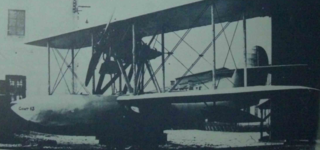The Nikitin-Schyevchyenko IS series, were single seat polymorphic fighters designed and produced in the USSR from 1938.

The Zeppelin-Lindau Rs.II was a biplane flying boat, designed by Claudius Dornier as a follow-on to his Zeppelin-Lindau Rs.I and built during 1914–1915 on the German side of Lake Constance. Initially this aircraft was powered by three engines mounted inside the hull driving three pusher propellers via gearboxes and shafts. The later version was powered by four engines in two push-pull nacelles mounted between the wings.

The ASL Viking was a single-engined two seater biplane aircraft designed and built by Horatio Barber's Aeronautical Syndicate Ltd. at Hendon. It was first flown in January 1912.
The Gabardini biplane was an Italian single seat biplane, designed and built near the beginning of World War I. It was an advanced trainer and could be fitted with engines of output between about 40 to 80 kW.

The Caudron C.74 was a ten-seat, four engine passenger biplane built in France in 1922. It showed promise but the sole prototype crashed fatally in a competition and no more were completed.

The Caudron C.68 was a two-seat French training and touring aircraft, built in the early 1920s, which attracted interest at the time because of its simple and fast wing folding arrangement. Only a few were produced.

The Latham HB.5 was a French biplane flying boat with four engines in push-pull configuration pairs. Ten were used by the French Navy.
The Latham E-5 was a large French Naval four engine biplane flying boat, flown in 1925. It was successfully tested but only one was built.
The Latham Trimotor was a large French trimotor biplane built just after World War I and used in small numbers by the French Navy.
The Caproni Ca.61 was an Italian heavy day bomber aircraft of 1922. It was the final development of the Caproni three engine, twin boom biplane types developed during World War I, but it was not put into production.
The Caproni Ca.66 was an Italian night bomber designed to reequip the post-World War I Italian Air Force. Only two examples of the four-engined biplane were built.

The Aerial Service Mercury Senior, Aerial Mercury Senior or just Mercury Senior was a US biplane mailplane designed to operate at night between New York City and Chicago. A different, smaller, lower wing improved its performance for daytime flights. One was built and used by the United States Post Office Department.

The Denhaut Hy.479 was a French flying boat flown in 1926 and intended to be suitable for commercial or military applications. Only one, in military configuration, was built and was sometimes known as the France-Aviation Denhaut.
The CANT 12 was a flying boat and training aircraft that was produced in Italy in the 1920s.

The CANT 13 was an amphibious aircraft designed for use on Regia Marina ships in response to a 1925 competition.
The Caproni Ca.103 was a biplane twin-engine bomber developed by the Italian company Aeronautica Caproni in the late 1920s.

The CANT 23 was an Italian trimotor airliner built by CANT in the late 1920s.
The CANT 35 was an Italian reconnaissance flying boat built by CANT in the early 1930s.
The LFG V 8 Bärbel (Barbel) in English) was a small, single-engined, biplane flying boat which carried two passengers. The sole example was built in Germany shortly after World War I but was exported and used for Baltic flights.

The Ireland Neptune was a four or five place pusher configuration biplane sold in flying boat and amphibian versions. Designed in the U.S. and first flown in 1927, well over 50 were built.










